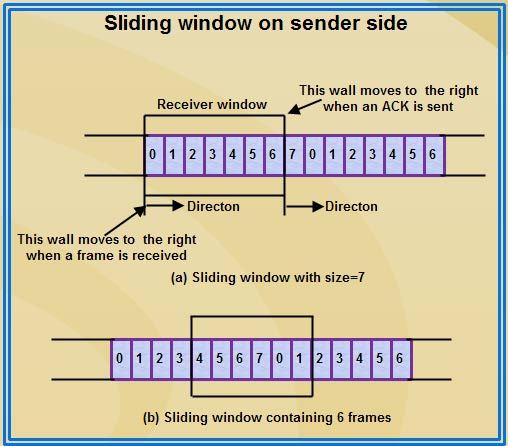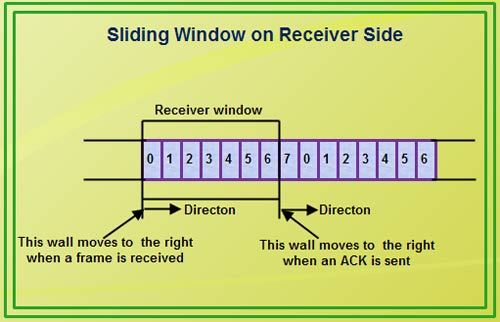• In sliding window method, multiple frames are sent by sender at a time before needing an acknowledgment.
• Multiple frames sent by source are acknowledged by receiver using a single ACK frame.
We’ll be covering the following topics in this tutorial:
Sliding Window
• Sliding window refers to an imaginary boxes that hold the frames on both sender and receiver side.
• It provides the upper limit on the number of frames that can be transmitted before requiring an acknowledgment.
• Frames may be acknowledged by receiver at any point even when window is not full on receiver side.
• Frames may be transmitted by source even when window is not yet full on sender side.
• The windows have a specific size in which the frames are numbered modulo- n, which means they are numbered from 0 to n-l. For e.g. if n = 8, the frames are numbered 0, 1,2,3,4,5,6, 7, 0, 1,2,3,4,5,6, 7, 0, 1, ….
• The size of window is n-1. For e.g. In this case it is 7. Therefore, a maximum of n-l frames may be sent before an acknowledgment.
• When the receiver sends an ACK, it includes the number of next frame it expects to receive. For example in order to acknowledge the group of frames ending in frame 4, the receiver sends an ACK containing the number 5. When sender sees an ACK with number 5, it comes to know that all the frames up to number 4 have been received. 
Sliding Window on Sender Side
• At the beginning of a transmission, the sender’s window contains n-l frames.
• As the frames are sent by source, the left boundary of the window moves inward, shrinking the size of window. This means if window size is w, if four frames are sent by source after the last acknowledgment, then the number of frames left in window is w-4.
• When the receiver sends an ACK, the source’s window expand i.e. (right boundary moves outward) to allow in a number of new frames equal to the number of frames acknowledged by that ACK.
• For example, Let the window size is 7 (see diagram (a)), if frames 0 through 3 have been sent and no acknowledgment has been received, then the sender’s window contains three frames – 4,5,6.
• Now, if an ACK numbered 3 is received by source, it means three frames (0, 1, 2) have been received by receiver and are undamaged.
• The sender’s window will now expand to include the next three frames in its buffer. At this point the sender’s window will contain six frames (4, 5, 6, 7, 0, 1). (See diagram (b)).

Sliding Window on Receiver Side
• At the beginning of transmission, the receiver’s window contains n-1 spaces for frame but not the frames.
• As the new frames come in, the size of window shrinks.
• Therefore the receiver window represents not the number of frames received but the number of frames that may still be received without an acknowledgment ACK must be sent.
• Given a window of size w, if three frames are received without an ACK being returned, the number of spaces in a window is w-3.
• As soon as acknowledgment is sent, window expands to include the number of frames equal to the number of frames acknowledged.
• For example, let the size of receiver’s window is 7 as shown in diagram. It means window contains spaces for 7 frames.
• With the arrival of the first frame, the receiving window shrinks, moving the boundary from space 0 to 1. Now, window has shrunk by one, so the receiver may accept six more frame before it is required to send an ACK.
• If frames 0 through 3 have arrived but have DOC been acknowledged, the window will contain three frame spaces.
• As receiver sends an ACK, the window of the receiver expands to include as many new placeholders as newly acknowledged frames.
• The window expands to include a number of new frame spaces equal to the number of the most recently acknowledged frame minus the number of previously acknowledged frame. For e.g., If window size is 7 and if prior ACK was for frame 2 & the current ACK is for frame 5 the window expands by three (5-2).

• Therefore, the sliding window of sender shrinks from left when frames of data are sending. The sliding window of the sender expands to right when acknowledgments are received.
• The sliding window of the receiver shrinks from left when frames of data are received. The sliding window of the receiver expands to the right when acknowledgement is sent.
 Dinesh Thakur holds an B.C.A, MCDBA, MCSD certifications. Dinesh authors the hugely popular
Dinesh Thakur holds an B.C.A, MCDBA, MCSD certifications. Dinesh authors the hugely popular